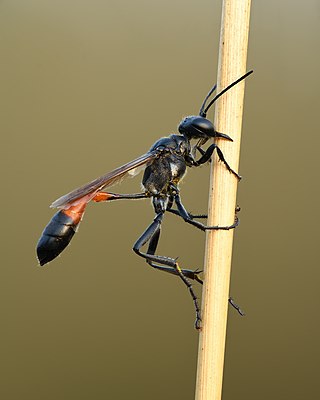
The Sphecidae are a cosmopolitan family of wasps of the suborder Apocrita that includes sand wasps, mud daubers, and other thread-waisted wasps.
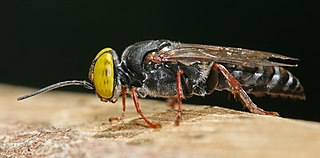
The Crabronidae are a large paraphyletic group of wasps, including nearly all of the species formerly comprising the now-defunct superfamily Sphecoidea. It collectively includes well over 200 genera, containing well over 9000 species. Crabronids were originally a part of the Sphecidae, but the latter name is now restricted to a separate family based on what was once the subfamily Sphecinae. Several of the subfamilies of the Crabronidae are often treated as families in their own right, as is true of the most recent phylogenies.

Sceliphron, also known as black mud daubers or black mud-dauber wasps, is a genus of Hymenoptera of the Sphecidae family of wasps. They are solitary mud daubers and build nests made of mud. Nests are frequently constructed in shaded niches, often just inside of windows or vent openings, and it may take a female only a day to construct a cell requiring dozens of trips carrying mud. Females will add new cells one by one to the nest after each cell is provisioned. They provision these nests with spiders, such as crab spiders, orb-weaver spiders and jumping spiders in particular, as food for the developing larvae. Each mud cell contains one egg and is provided with several prey items. Females of some species lay a modest average of 15 eggs over their whole lifespan. Various parasites attack these nests, including several species of cuckoo wasps, primarily by sneaking into the nest while the resident mud dauber is out foraging.

The organ pipe mud dauber is a predatory wasp in the family Crabronidae. It is fairly large, ranging from 3.9–5.1 cm, and has been recorded to fly from May to September. Females and males are similar in colour, a shiny black, with the end part of the back leg being pale yellow to white. The organ pipe mud dauber feeds mainly on three genera of spider: Neoscona, Araneus, and Eustala. Melittobia, a parasitoid wasp, is a common ectoparasite of T. politum prepupae. Other sources of parasitism include the bombyliid fly Anthrax, chrysidid wasps, and various species of scavenger flies (Miltogramminae). The tufted titmouse is a known predator of T. politum, and may feed on them more commonly than previously thought, as the holes made by the titmouse are similar in shape and size to those made by T. politum leaving the nest after pupation.

Potter wasps, the Eumeninae, are a cosmopolitan wasp group presently treated as a subfamily of Vespidae, but sometimes recognized in the past as a separate family, Eumenidae.

Pison is a cosmopolitan genus of wasps within the family Crabronidae. The genus comprises 145 described species, although many species, especially in South America remain undescribed.

Larra, also known as mole cricket wasps or mole cricket hunters, is a genus of wasps that prey on various species of mole crickets. They have gained prominence as integrated pest management agents.

Pemphredonidae is a family of aphid wasps formerly treated as the subfamily Pemphredoninae. There are 19 genera and 556 described species in the family.
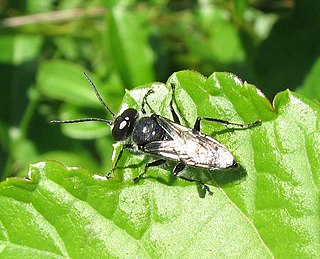
Astata is a cosmopolitan genus of solitary predatory wasps in the family Astatidae. They are known to prey on adults and nymphs of Pentatomidae. Astata is the largest genus in this subfamily, and is identified by features of its wing venation. The males of this genus and the related genus Dryudella have very large compound eyes that broadly meet at the top of the head.

Isodontia mexicana, the Mexican grass-carrying wasp, is a species of insect belonging to the family Sphecidae. It is mainly found throughout North America, but has become established in Europe, primarily France, Switzerland, Hungary, Italy, Serbia, and Spain.
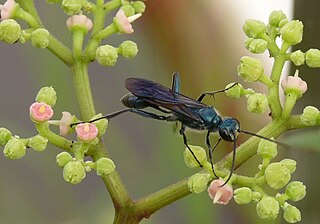
Chalybion is a genus of blue mud dauber wasps in the family Sphecidae. Chalybion species nest in a wide range of natural and artificial cavities such as holes in wood, walls, plant stems, etc., where they typically provision their brood cells with paralyzed spiders. They also reuse old nests of other wasps like Trypoxylon and Sceliphron.

Ammophila is the type genus of the subfamily Ammophilinae of the hunting wasp family Sphecidae. Ammophila is a large and cosmopolitan genus, with over 200 species, mostly occurring in the warmer regions of all continents apart from Antarctica.
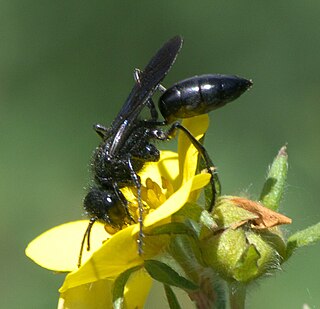
Podalonia is a genus of parasitoidal wasps in the family Sphecidae.

Nysson is a Holarctic genus of kleptoparasitic wasps in the family Crabronidae. Over 100 species are known.
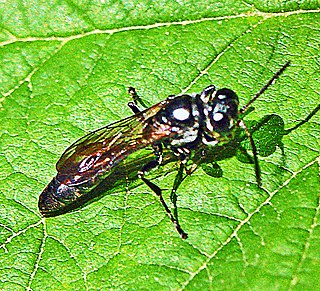
Trypoxylon scutatum is a predatory wasp in the family Crabronidae.

Psenidae is a family of aphid wasps in the superfamily Apoidea formerly treated as the tribe Psenini. There are 12 genera and at least 485 described species of Psenidae.
Trypoxylon lactitarse is a species of square-headed wasp in the family Crabronidae. It is found in North, Central, and South America, and said to range from Canada to Argentina. These are fairly common harmless solitary wasps, although as with others of this same genus, the adult males can be observed to guard the nests. This species is well-characterised as nesting in pre-existing cavities which has facilitated ecological studies, as females can be easily attracted to nest in human-made trap-nests. Females construct a linear series of cells that are subdivided by mud partitions. In the south of range, nesting activity has been recorded to occur throughout the year, although may be more common in certain months. They can begin construction of their nests with a layer of mud, followed by the formation of a linear series of 6-8 cells.

Dolichurus is a genus of cockroach wasps in the family Ampulicidae; they are generally found on dead wood, leaf litter, or on tree trunks. There are at least 50 described species in Dolichurus.


















